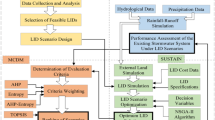Abstract
Low impact development best management practices (LID-BMPs) are considered to be cost-effective measures for mitigating the water quantity and quality impact of urban runoff. Currently, there are many types of LID-BMPs, and each type has its own intrinsic technical and/or economical characteristics and limitations for implementation. The selection of the most appropriate BMP type(s) for a specific installation site is therefore a very important planning step. In the present study, a multi-criteria selection index system (MCIS) for LID-BMP planning was developed. The selection indexes include 12 first-level indices and 26 second-level indices which reflect the specific installation site characteristics pertaining to site suitability, runoff control performance, and economics of implementation. A mechanism for ranking the BMPs was devised. First, each individual second-level index was assigned a numeric value that was based on site characteristics and information on LID-BMPs. The quantified indices were normalized and then integrated to obtain the score for each of the first-level index. The final evaluation scores of each LID-BMP were then calculated based on the scores for the first-level indices. Finally, the appropriate BMP types for a specific installation site were determined according to the rank of the final evaluation scores. In order to facilitate the application of the MCIS BMP ranking system, the computational process has been coded into a software program, BMPSELEC. A case study demonstrating the MCIS methodology, using an LID-BMP implementation planning at a college campus in Foshan, Guangdong Province, is presented.










Similar content being viewed by others
References
Baptista, M., Barraud, S., & Alfakih, E. (2001). Data analysis for the elaboration of technical and economic indicators of alternative stormwater drainage systems. Proceeding of 4th International Conference On Innovative Technologies In Urban Drainage, Novatech2001, Villeurbanne, France (in French).
Cheng, M. S., Zhen, J., & Shoemaker, L. (2009). BMP decision support system for evaluating stormwater management alternatives. Frontiers of Environmental Science & Engineering in China, 3(4), 453–463.
Gitau, M. W., Veith, T. L., & Gbrurek, W. J. (2004). Farm-level optimization of BMP placement for cost-effective pollution reduction. Transactions of the ASAE, 47(6), 1923–2004.
Hunt, W.F., & Lord, W.G. (2006). Bioretention performance, design, construction, and maintenance. North Carolina Cooperative Extension Service Bulletin. Urban Waterways Series. AG-588-5. North Carolina State University, Raleigh, NC.
Jia, H. F., Lu, Y. W., Zhen, X., & Yu, S. L. (2012). Planning of LID-BMPs for urban runoff control: the case of Bei**g Olympic village. Separation and Purification Technology, 84, 112–119.
Li, S. P., & Huang, T. L. (2002). Influence on rainfall run-off due to urbanization and rain-water flood control in the city. China Municipal Engineering (3), 35–37, 67 (in Chinese).
Revitt, D. M., & Ellis, J. B. (2001). Drainage, runoff and groundwater. In G. Mudge (Ed.), Guidelines for the environmental management of highways (pp. 67–102). London: Institution of Highways & Transportation.
Revitt, D. M., Ellis, J. B., & Scholes, L. (2003). Review of the use of storm water BMPs in Europe. Report 5.1. EU 5th Framework DayWater Project. Middlesex University.
Scholes, L., Revitt, D.M., & Ellis, J.B. (2005). Determination of numerical values for the assessment of BMPs. Middlesex University.
Shoemaker, L., Riverson,J., Khalid, A., Zhen, J., Sabu, P., & Rafi, T. (2009). SUSTAIN, a framework for placement of best management practices in urban watersheds to protect water quality. Report EPA/600/R-09/095, USEPA, Washington, DC, USA.
The Ministry of Construction, PRC. (1991). City Land Use Classification and Development Standards (GBJ137-90), Bei**g. (in Chinese).
USDA NRCS. (1986). Urban hydrology for small watersheds-Technical Release 55(TR55), Second Ed. Washington, DC: U.S. Department of Agriculture (USDA).
USEPA. (1999). Preliminary data summary of urban stormwater best management practices. EPA-821-R-99-012. Washington, DC: USEPA.
USEPA. (2004a). Stormwater best management practice design guide. EPA/600/R-04/121. Washington, DC: USEPA.
USEPA. (2004b). The use of best management practices (BMPs) in urban watersheds. EPA/600/R-04/184. Washington, DC: USEPA.
Viavattene, C., Ellis, J. B., Revitt, D. M., Seiker, H., & Peters, C. (2010). The application of a GIS-based BMP selection tool for the evaluation of hydrologic performance and storm flow reduction. Proceeding of 7th International Conference on Sustainable Techniques and Strategies for Urban Water Management; NOVATECH2010, Lyon, France.
Young, K. D., Younos, T., Dymond, R. L., Kibler, D., & Lee, D. H. (2010). Application of the analytical hierarchy process for selecting and modeling stormwater best management practices. Journal of Contemporary Water Resources and Education, 146, 50–63.
Zhen, X., & Yu, S. L. (2004). Optimal location and sizing of stormwater basins at watershed scale. Journal of Water Resources Planning and Management, 130(4), 339–347.
Acknowledgments
We thank Mr. Yongchang Yu of the Foshan Municipal Environmental Protection Bureau for his assistance in data collection and analysis. Funding for the study was provided by the Programme of Introducing Talents of Discipline to Universities (B07002), Natural Science Foundation Project (51278267) and the National Water Pollution Control Special Project (no. 2011ZX07301-003). The authors would like to especially thank Ms. Yurong Chen of the School of Environment, Tsinghua University for her assistance in data analysis and in preparing some of the figures.
Author information
Authors and Affiliations
Corresponding author
Rights and permissions
About this article
Cite this article
Jia, H., Yao, H., Tang, Y. et al. Development of a multi-criteria index ranking system for urban runoff best management practices (BMPs) selection. Environ Monit Assess 185, 7915–7933 (2013). https://doi.org/10.1007/s10661-013-3144-0
Received:
Accepted:
Published:
Issue Date:
DOI: https://doi.org/10.1007/s10661-013-3144-0




